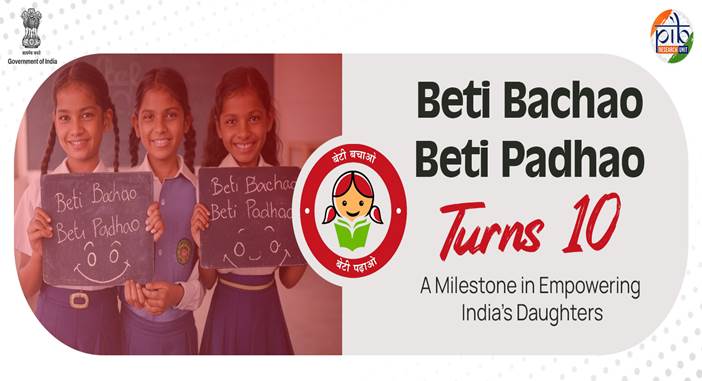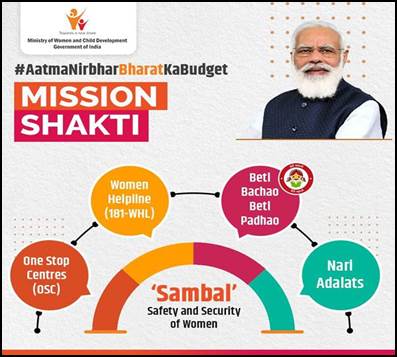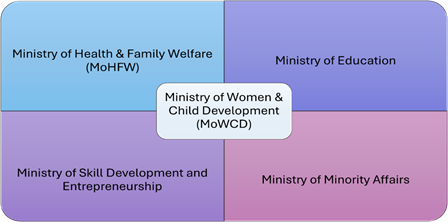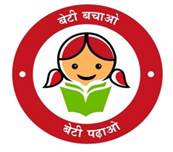Ministry of Women and Child Development
Empowering India's Daughters
A Decade of Beti Bachao Beti Padhao’s Success
Posted On:
21 JAN 2025 8:10PM by PIB Delhi
|
“In every development initiative undertaken by our Government, we accord immense priority to empowering the girl child and strengthening our Nari Shakti. Our focus is on ensuring dignity as well as opportunities to the girl child.”
Shri Narendra Modi, Prime Minister of India
|
The Beti Bachao Beti Padhao (BBBP) scheme, launched by Prime Minister, Shri Narendra Modi on 22nd January, 2015, in Panipat, Haryana, is completing a decade of implementation. This flagship initiative by the Government of India aims to address the declining Child Sex Ratio (CSR), prevent gender-biased sex-selective elimination and promote the survival, protection and education of the girl child. The scheme has evolved to become one of the most impactful social initiatives by the Indian government.

Integration with Mission Shakti

The BBBP scheme is now integrated with Mission Shakti, a comprehensive program for women’s safety and empowerment, for implementation during the 15th Finance Commission period from 2021-2022 to 2025-2026. Mission Shakti consists of two broader sub-schemes –
- Sambal: Safety and Security
Mission Shakti’s Sambal sub-scheme ensures women’s safety through One Stop Centres (OSCs), Women Helpline (181), and Beti Bachao Beti Padhao (BBBP), now expanded nationwide. It also introduces Nari Adalat, providing an alternate grievance redressal mechanism for resolving minor issues like harassment and rights violations.
- Samarthya: Empowerment - The Samarthya sub-scheme empowers women through Shakti Sadans, relief and rehabilitation homes, Sakhi Niwas, providing safe and secure place for stay for working women in the cities, and Palna-Creche providing safe and secure place for children of working women. The Pradhan Mantri Matru Vandana Yojana (PMMVY) now supports a second child if it’s a girl, enhancing maternal health. It also compensates for loss of wages due to pregnancy and childbirth.
The scheme now emphasizes a multi-sectoral approach, involving health, education, child development, and community awareness. Over the past decade, BBBP has expanded its scope through collaborations between multiple ministries.

Key Objectives
The primary objectives include:

- Preventing gender-biased sex-selective elimination.
- Ensuring survival and protection of the girl child.
- Promoting education and participation of the girl child.
- Improving Sex Ratio at Birth (SRB) by two points every year.
- Improvement in the percentage of institutional deliveries or sustained at the rate of 95% or above.
- 1% increase in 1st Trimester Anti-Natal Care (ANC) Registration per year.
- To check dropout rate among girls at secondary and higher secondary levels.
- Raising awareness about safe Menstrual Hygiene Management (MHM).
Focus Areas and Target Groups
The scheme primarily focuses on:
- Young and newly married couples, expecting parents
- Adolescents (girls and boys) and youth
- Households and communities
- Schools, Anganwadi Centers (AWCs),
- Medical doctors/professionals, private hospitals, nursing homes, diagnostic centres etc.
- Panchayat Raj Institutions (PRIs), Urban Local Bodies (ULBs), officials, frontline workers
- Women Collectives and Self-Help Groups (SHGs) and Civil Society Organizations
- Media, religious leaders, and industry experts
Financial and Operational Structure
BBBP is a centrally sponsored scheme with 100% funding by the Central Government in all the districts of the country under Sambal vertical of Mission Shakti.
Financial assistance varies based on the Sex Ratio at Birth (SRB) in districts:
- Rs. 40 Lakh per year for districts with an SRB of ≤918.
- Rs. 30 Lakh for districts with an SRB between 919-952.
- Rs. 20 Lakh for districts with an SRB of >952.
Key Developments
The campaign's success is evident in the strides it has made toward addressing gender disparities, with impressive data reflecting its positive impact on society.
1. Improvement in Sex Ratio at Birth (SRB)
· From an SRB of 918 in 2014-15, the national SRB improved to 933 in 2022-23 (Source: HMIS, MoHFW). This steady increase showcases the collective impact of BBBP in raising awareness around the gender-biased practices that negatively affect the sex ratio.
2. Increase in Girl's Enrollment in Secondary Education
- Girls' enrollment in secondary education has seen a significant increase, with the Gross Enrollment Ratio (GER) for girls rising from 75.51% in 2014-15 to 79.4% in 2021-22 (Source: U-DISE Plus, MoE). This reflects the positive influence of BBBP's educational interventions.
3. Increased Institutional Deliveries
- BBBP also emphasized improving healthcare access for women. Institutional deliveries rose from 87% in 2014-15 to over 94% by 2019-20, ensuring safer childbirths for mothers and infants in many regions, which has been essential in reducing maternal and infant mortality rates.
4. Awareness Campaigns
- Specific campaigns like ‘Selfie with Daughters’ targeted at fathers with girl child gained nationwide traction.
- Community-level activities such as ‘Beti Janmotsav’ to celebrate the birth of girl child.
5. Skilling and Economic Empowerment of Women
- In collaboration with the Ministry of Skill Development and Entrepreneurship, BBBP has made strides in promoting skill development among young girls and women, enhancing their economic participation. Vocational training programs have been introduced. The scheme also introduced specific initiatives for higher education and skill development for girls from minority communities.
- Programs like ‘Khelo India’ aims to identify and nurture sporting talent among girls.
Key Interventions
The scheme operates through two major components:
Multi-Sectoral Interventions
Promoting sports among girls, self-defence camps, construction of girls’ toilets, making available sanitary napkin vending machines and sanitary pads especially in educational institutions, awareness about PC-PNDT Act.
Awareness Campaigns & Community Engagements
National Girl Child Day (NGCD) is celebrated annually on 24th January with campaigns, workshops, and creative competitions. A cross-country bike expedition, "Yashaswini", a group of 150 CRPF women bikers to celebrate women power or Nari Shakti of the country. Focus on menstrual hygiene, self-defence, and gender equality to empower girls holistically. Community sensitization programs such as workshops on menstrual hygiene were held with the distribution of hygiene kits.
Conclusion
The Beti Bachao Beti Padhao (BBBP) scheme has made significant progress in improving the lives of girls in India. It has helped improve the Sex Ratio at Birth, increase access to education, expand healthcare, and support women’s economic empowerment. By working with government bodies, NGOs, and local communities, the scheme has created a strong foundation for valuing and protecting every girl child. As BBBP enters its second decade, the focus will be on making long-term changes through inclusive policies, better implementation, and active community participation. This will ensure continued progress toward gender equality and empowerment.
References
Click here to download PDF
*******
Santosh Kumar/Binoykumar C V/ Gouri S/ Vatsla Srivastava
(Release ID: 2094929)
Visitor Counter : 913